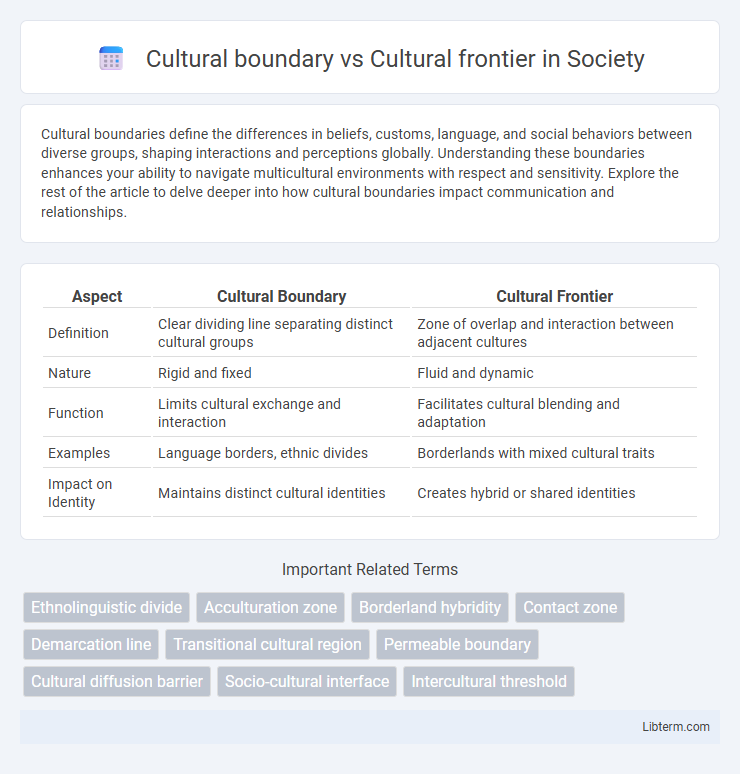Cultural boundaries define the differences in beliefs, customs, language, and social behaviors between diverse groups, shaping interactions and perceptions globally. Understanding these boundaries enhances your ability to navigate multicultural environments with respect and sensitivity. Explore the rest of the article to delve deeper into how cultural boundaries impact communication and relationships.
Table of Comparison
| Aspect | Cultural Boundary | Cultural Frontier |
|---|---|---|
| Definition | Clear dividing line separating distinct cultural groups | Zone of overlap and interaction between adjacent cultures |
| Nature | Rigid and fixed | Fluid and dynamic |
| Function | Limits cultural exchange and interaction | Facilitates cultural blending and adaptation |
| Examples | Language borders, ethnic divides | Borderlands with mixed cultural traits |
| Impact on Identity | Maintains distinct cultural identities | Creates hybrid or shared identities |
Introduction to Cultural Boundaries and Frontiers
Cultural boundaries define distinct divisions between different cultural groups marked by language, religion, or customs, creating clear separations on maps and in social interactions. Cultural frontiers, on the other hand, represent transitional zones where two or more cultures interact, blend, and influence each other, resulting in dynamic and fluid cultural exchanges. Understanding these concepts is essential for studying human geography, social integration, and cultural diffusion across regions.
Defining Cultural Boundaries
Cultural boundaries represent clearly defined geographical lines separating distinct cultural groups, often linked to language, religion, or ethnicity that create rigid divisions between communities. In contrast, cultural frontiers are dynamic zones where cultures meet, overlap, and gradually blend, resulting in fluid and flexible cultural expressions rather than strict separations. Defining cultural boundaries involves identifying specific markers such as language dialects, religious practices, or historical territorial claims that signify clear cultural differentiation.
Understanding Cultural Frontiers
Cultural frontiers represent dynamic zones where distinct cultural groups interact, exchange, and influence one another, often leading to gradual blending or hybrid cultural identities. Unlike rigid cultural boundaries that demarcate clear separation between cultures, cultural frontiers are characterized by permeability and ongoing negotiation of cultural traits, values, and practices. Understanding cultural frontiers involves recognizing the fluidity of cultural interactions and the processes of adaptation and transformation occurring in these shared spaces.
Key Differences Between Boundaries and Frontiers
Cultural boundaries are clearly defined lines separating distinct cultural groups, often recognized through language, religion, or ethnicity, while cultural frontiers represent zones where cultures overlap and blend without sharp divisions. Boundaries typically involve formal agreements or historical claims, creating exclusive territorial limits, whereas frontiers serve as transitional areas fostering interaction, exchange, and hybrid cultural traits. Understanding this distinction is crucial for analyzing cultural integration, conflict, and identity formation in geography and anthropology.
Historical Examples of Cultural Boundaries
Cultural boundaries denote defined and recognized divisions between distinct cultural groups, as seen in the partition between Hindu and Muslim regions during the 1947 India-Pakistan independence, which reshaped national identities and caused massive population displacement. In contrast, cultural frontiers represent more fluid zones where cultures interact and blend, exemplified by the American West in the 19th century, where Native American, European, and settlers' cultures merged and clashed along expanding territorial lines. Historical examples of cultural boundaries highlight how fixed separations influence geopolitical conflicts and social dynamics, whereas cultural frontiers emphasize cultural exchange and adaptation processes.
Case Studies of Cultural Frontiers
Cultural frontiers are zones of interaction where distinct cultures meet and exchange ideas, customs, and practices, often resulting in hybrid cultural identities, unlike cultural boundaries which are strictly demarcated borders separating different cultural groups. Case studies of cultural frontiers include the US-Mexico border, where blending of Anglo and Hispanic cultures creates unique bilingual communities, and the Himalayan region, where Tibetan, Nepali, and Indian cultures intersect, fostering shared religious and social traditions. These frontiers highlight dynamic cultural negotiation and adaptation rather than rigid segregation, reflecting fluid cultural landscapes.
Factors Influencing Cultural Boundaries
Cultural boundaries are shaped by linguistic, religious, and ethnic differences that create clear divisions between groups, while cultural frontiers represent zones of gradual cultural blending and interaction. Factors influencing cultural boundaries include historical conflicts, migration patterns, and geographic barriers such as mountains and rivers, which reinforce separation. Social institutions, trade networks, and political policies further define the rigidity or permeability of these cultural divisions.
The Role of Language and Religion
Cultural boundaries are defined by clear divisions where language and religion distinctly separate one group from another, often resulting in limited interaction and reinforced social identities. In contrast, cultural frontiers represent zones where linguistic and religious traits blend, facilitating cultural exchange and hybridization. The dynamic interplay of language and religion in these areas shapes social cohesion and cultural evolution through continuous negotiation and adaptation.
Impact on Societies and Development
Cultural boundaries often create clear divisions between societies, leading to distinct social identities and potential conflicts that influence political and economic development. Cultural frontiers, by contrast, represent overlapping zones where cultures interact, blend, and exchange ideas, fostering innovation and social cohesion. These frontiers stimulate economic growth and enhance cultural diversity by promoting cross-cultural communication and cooperation.
Contemporary Relevance and Globalization
Cultural boundaries represent clear demarcations between distinct cultural groups, often maintaining traditional identities despite globalization's blending forces. Cultural frontiers, however, are fluid zones where different cultures interact, exchange, and evolve, reflecting the dynamic nature of contemporary global interconnectedness. In the era of globalization, understanding these concepts is crucial for managing multicultural integration, transnational migration, and international cooperation.
Cultural boundary Infographic

 libterm.com
libterm.com